
The best kinds of moviegoing experiences are those that feel like a huge, celebrated event. When you’re a kid, everything is bigger, so going to the movie theater was a big deal - serious shit. Some of the magic dissipates as you grow, however. The screen never seems as big (unless you do the whole Imax thing, which I have never experienced). Perhaps that’s how it is for most people, especially those who may have only seen a big-screen film on occasion during their childhoods. What makes a night out at the movies really special, however, is if there is extra anticipation attached to the event. Perhaps the film is one the viewer has been looking forward to for quite some time. Or, perhaps it is only part of an all-night lineup of activities or even other movies. For this particular event, both were the case. Whatever the reasons, when a night out at the movies elevates itself above passive entertainment, something wonderful called rediscovered youth happens.

You do not want to look out your window and see THAT.
Our youth is hardly lost, but for tonight, we had an opportunity to take our usual monthly monster film fests and give them a shot of growth hormone. The name of the medication has only three letters: G, M, and K. That is, Godzilla, Mothra, and King Ghidorah: Giant Monsters All-Out Attack, the most popular, highly-anticipated and greatly hailed of the 2000-era Godzilla movies. And, a really big deal for us Godzilla freaks. In fact, Jared and I kept referring to the night’s showing as “GM-fuckin’-K.” Out of the blue, Jared discovered that Atlanta’s Plaza Theatre was doing their usual “Silver Scream Spook Show” feature, and that our favorite film icon was at the center. We had previously seen the original Mothra at the Spook Show, and unfortunately missed a showing of Godzilla vs. the Sea Monster. There will likely be many more Japanese monster movies at the Plaza, but we just couldn’t pass this up. GMK. GM-fuckin-K.
Why is GMK such a big deal? The answer is obvious for most Godzilla fans (I say most because the film is in fact a divisive issue among G-fans, a fraction of them asking the very same question from the beginning of this paragraph). GMK came on the heels of a “not-bad” revamp movie and a so-so follow-up. Godzilla was back, but not with much of a bang. In comes Shusuke Kaneko: instant marquee value and not a bad director, either. While he’s done work on nearly every genre imaginable (even soft porn), Kaneko is known among fans for taking Gamera, everyone’s favorite flying, fire-belching, kiddy-loving turtle, and throwing him into a trilogy of films with effects and storytelling that trumped the Godzilla movies of that time. Part three is also notoriously dark in tone, and transformed Gamera, though still a good guy, into a hideous, terrifying nightmare. When Kaneko was announced to direct GMK in 2001, the thought on everyone’s mind was: “imagine what this guy can do for Godzilla.”

If you’re in a room full of Godzilla fans, this shot would bring applause
GMK is also the first of the “Millenium” Godzilla movies to bring back old foes. Mothra and King Ghidorah added even more marquee value (the original script called for more obscure monsters), and though some fans disliked the obvious shoehorned roles, there was excitement to see these two creatures “done right,” as they’ve never looked better than when special effects master Eiji Tsuburaya brought them to life in the 1960’s (until now!) The real excitement about the monster cast, however, was Baragon. An underdog fan-favorite. Everyone wanted to see Godzilla through the eyes of Shusuke Kaneko as well. During pre-production, the director unveiled the design for the creature, which was stylized in the old-school 1960’s fashion, but with bleached-white eyes to emphasize Godzilla’s new supernatural angle (he is said to be the conglomeration of the souls of all the World War II dead). The Godzilla suit was also touted as the largest in the series: over seven feet.
Even though the film was followed by three more, including the hugely marketed 50th anniversary film, GMK is still considered by many the best of the new Godzilla movies. In fact, the host of the Spook Show, “Professor Morte,” told the crowd that this was the 2nd best Godzilla movie ever. Not every Godzilla fan may agree with that, but it definitely shows the enthusiasm that went into the event.

“Betcha I can shoot down that helicopter!”
So, the usual G.H.I.D.R.A.H. crowd, myself, Jared, Clayton, and Jae, as well as two brand-new people along for the ride, Sadie and Stephanie, made our way to the Plaza theater after a quick dinner at Manuel’s Tavern (us guys had “Dogzillas,” appropriately).
The Plaza sits on Ponce de Leon Avenue next to The Righteous Room. While not a huge venue, it’s marquee is hard to miss, especially when the word Godzilla is on it. The theater only recently began to develop its focus on live events to compliment its films. Established in 1939, the theater originally catered to the upscale shoppers of the Briarcliff Plaza Shopping Center. Times changed, and so did the types of films, and in the ‘80s the theater was bought by Georgia Lefont, who turned the balcony into a second screening room. In 2006, Lefont sold the theater to Jonathan and Gayle Rej. Immediately afterwards, events such as “Splatter Cinema,” “Flicks and Giggles,” and the much-appreciated Spook Show were implemented. Thanks to the Plaza’s new owners, movies are now being transformed into memorable events.

The Plaza is made for cult movie fans, if this marquee doesn’t prove it already.
As before, when Jared and I saw Mothra, memorabilia was set about; issues of G-Fan and the Dark Horse Godzilla comics were displayed on a table in the lobby as prizes for a drawing, and a mural of Godzilla reaching out to his fans hung near the main screen entrance. As we found our seats, music from King Kong vs. Godzilla played over the loudspeakers (from one of the “Best of Godzilla” CDs).
The “Spook Show” acted on the stage before the film almost made the night. When Jared and I saw Mothra, we were anxious for the movie to get started. For GMK, the show perfectly complimented the film and raised everyone’s spirits. Professor Morte and his assistant began the night by first introducing the film, which they were also clearly excited about. Since the film was about giant monsters, they decided to make some of their own, turning a piece of sushi from Publix (“ooh, that’s scary!” Morte’s assistant commented) into a huge fish roll, and transforming a shrimp into Godzilla’s nemesis Ebirah, who then ran off with the sushi. A Mothra-themed song-and-dance number followed, with two schoolgirls in “I love Mothra” shirts wrapping their professor in a cocoon.
[I might want to note a suspicion of mine regarding the Spook Show staff’s Mothra obsession. Besides this recurring dance number, all three of the latest kaiju movies shown at the Plaza feature Mothra. This, of course, narrows down predictions for their next showing.]
The most ingenious portion of the show, which took a nod of the hat to GMK’s plot, followed next. A woman with an exaggerated Asian accent arrived with an ancient map and a warning: giant monsters were at this very moment sleeping under “Atranta.”
“Atranta?” asked Morte’s assistant. “Atranta” she confirmed.
They then traveled to different parts of the city, via imaginative backdrops, to keep the monsters asleep with a mega-dose sleeping pill. The best part was when they traveled to Lake Lanier, which was portrayed with blacklights and a moving sheet. The monster of the lake? An effective fluorescent-painted tentacle rising from the depths. On their way back to the city, the assistant exclaims that they have to travel through Piedmont Park. Immediately, “It’s Raining Men” came over the loudspeakers and scantily clad “gay guys” began swarming over the group.
The risqué humor and the homages to the genre made the stage show thoroughly enjoyable, but it would only get better. Turns out, the sleeping pills given to the monsters must be taken with food, or else they would awaken with “extreme irritability and hunger.” This is usually a good thing for monster fans. Luckily, they hatch Mothra (or a leather-clad woman with Mothra wings) to help out. Mothra and “The Giant Bigfoot” (a reference, I think, to Georgia’s Bigfoot hoax that made national news), then proceeded to have a WWE-style smack down amid a stage of model buildings, complete with Jerry Lawler-worthy commentary.
Mothra dispatched Bigfoot, but the only monster capable of downing Lake Lanier’s sea monster was Godzilla. So, they got him! Perhaps the biggest and best surprise of the night, an actor in an admirable Godzilla suit marched down the aisles to face his foe, with the famous Godzilla march playing. Stopping for the occasional roar or wave to his fans, Godzilla approached the monster, which was portrayed via an actor inside a giant slimy eyeball, attached to which were several wire-operated tentacles. Compared to the brawl between Mothra and the Bigfoot, this one was kind of lackluster; Godzilla stood and roared while the sea monster cowered from the scene. Not that that mattered. Just seeing a surprise appearance by “Godzilla” was worth it.
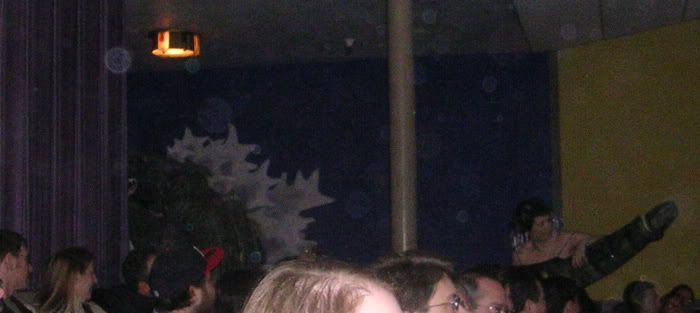
Almost got him on his way out, but Godzilla is in fact camera-shy.
After the crowd calmed down and the show’s cast made their final bows, it was time to start the real event. Now, as a Godzilla fan I must admit, I’ve probably seen GMK close to a dozen times (“What? That’s all?”). It’s actually not one of my favorites (gasp!). The damn-near perfect 1960s films and the unbelievably goofy and fun ‘70s movies rank pretty high on my scale. I even enjoyed all three follow-ups to GMK a little bit more than this film (Godzilla Against MechaGodzilla, Godzilla: Tokyo SOS, and Godzilla: Final Wars). Still, I liked it when it came out, and I recognized and appreciated the extra effort that went into it. And, it seems that I appreciate it more and more every time I see it, which is why I always look forward to watching GMK. And what better way to gain appreciation for it then on the big screen?
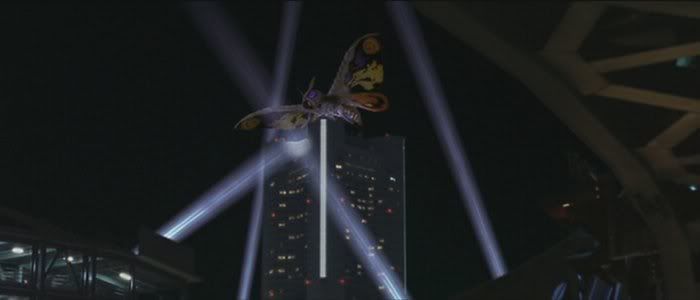
One of the coolest shots in the film. It holds up in motion, too.
The only significant letdown of the presentation that night was the fact that the film was dubbed. For a die-hard fan, dubs can completely ruin a film. I can admit, however, that there are some great dubs out there. The 1960’s films (here I go praising them again), featured dubs by professional actors from Titra and American International Pictures, who interjected wit and intelligence into what would otherwise be a flat translation of the Japanese dialogue.
My disappointment in the GMK dub is not a fan-driven bias; the dub is utterly horrible. Part of the unfortunate ranks of “international dubs,” quick translations done in Hong Kong for distribution purposes, with no intent for actual commercial use, the GMK dub flip-flops character traits on a whim, changes the meaning to lines, and features voice actors that are not, by professional trade, actors. Characters with gruff or deep voices trade off for feminine, little boy voices. Attractive female characters with button-cute faces borrow the misplaced gruff voices, making the audience wonder if someone forgot to take their estrogen. I could go on, but this is an event review, not a rant. Long and short of it, the dub sucks, but I can see why it was used. GMK had two showings: a matinee and a late-night showing, so it’s understandable that children attending the matinee would benefit from spoken lines.

“I’ve heard of a prison break, but this is ridiculous!”
Our group and the entire audience were still jazzed up from the stage show, and our spirits were too high to let a dub ruin the night. In fact, everyone visibly (and audibly) enjoyed the hell out of the movie. In the pre-credit sequence, Godzilla makes an eerie entrance, glimpsed swimming at the bottom of the ocean with his glowing back spines illuminating the scene in blue. At this, the audience broke out into applause, and would continue to do so for many moments during the film, such as a later scene when a dog, previously seen at the mercy of cruel teenagers, is revealed to have survived.

Toho and Godzilla veteran, the great Eisei Amomoto, in his last role.
Many fans of Shusuke Kaneko were looking forward to GMK as being one of the “darkest” Godzilla films, and to this day credit it as such, but when you actually watch the film, you wonder if perhaps they need to curb their enthusiasm a little. The film is a hoot. This Godzilla is the meanest and scariest of them all, that much is true, but he’s contrasted by Baragon, a big, loveable monster with every intentional resemblance to a puppy dog. There are many minor characters in the story that exist solely as comic relief. Such as the young military officer who is a closet monster-freak, energetically telling his superior that the monsters need names.
The intentional light-heartedness is an aspect not overlooked but ignored by a lot of fans. Kaneko, in fact, penned a much darker story about an astronaut returning from space, transforming into a horrible monster, and doing battle with Godzilla. The astronaut never returns to his natural form and goes on to live in personal exile for the rest of his life. Kaneko changed his mind about the script when he realized the film was to be released on New Years, which called for a higher-spirited story. So, he conceptualized GMK’s, which was meant to inspire audiences against selfishness and remember the importance of family and country. The current events referenced are dire and the message is brutally honest, but the final outcome has a light at the end of the tunnel (yes, there’s a happy ending, sorry to spoil it), and the humor does not feel out of place.
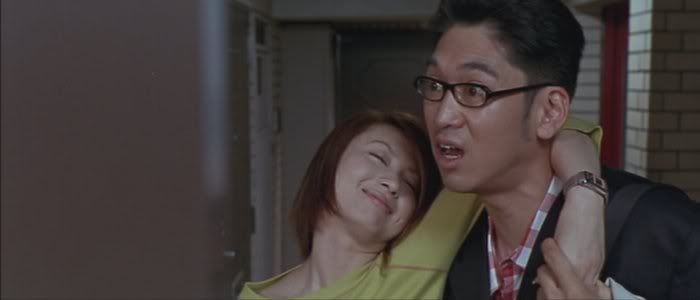
He has “oh shit” written all over his face.
None of this intentional humor was lost on the night’s audience, and they fully appreciated GMK for what it is and was intended to be, more so than some over-enthusiastic Godzilla fans. The only aspect the layman could not appreciate about GMK is the fact that its themes and references deal with current social issues in Japan, namely the festering ignorance and disrespect towards the country’s history and traditions amongst its population. But then again, enough of the theme shines through, even in the dub, that it strikes a chord with American audiences. After all, this is the country where Jay Leno can ask a “man on the street'” who the President was during the Civil War and receive “Richard Nixon” as an answer.
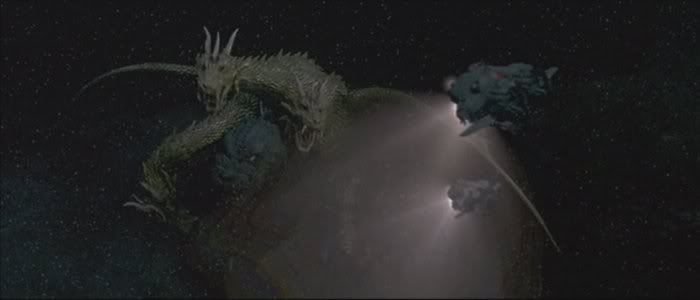
“Betcha I can shoot down one of those submarines!”
GMK has several moments of sheer shock and power that knock the viewers on their asses. When Godzilla’s fire breath is unveiled for the first time, the only carnage seen is a mushroom cloud rising in the distance, complimented by deep silence and a low rumble. At this, many “oohs,” “aahs,” and “holy-shits” were uttered.
The audience’s excitement was cranked up to “hop up and down in your seat” by the time Baragon faced off Godzilla, which is pretty much unanimously touted as the high point of the film. Thanks to the fantastic composites and miniatures, the rough and physical fight itself, the pure drama of how overmatched our “good monster” is (he’s a third the size of Godzilla!), coupled with the comic relief provided by two reporters treating the whole scene as a giant wrestling match, the audience could not stop “oohing” and “aahing.”
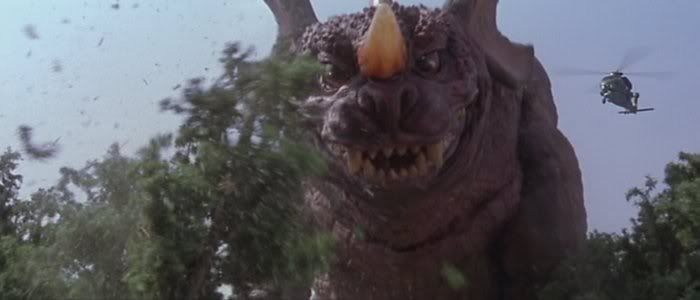
I’d pet him if I could reach him.
Like I said, though, this is the high point of the film, and I noticed as we approached the climax that the audience seemed a little less enthusiastic than before. Perhaps they were fully involved in the plot by this point, but I figured they had experienced what I have always noticed with GMK: that after Baragon and Godzilla’s titanic struggle, all the biggest and best fun has been had. The story may have a conclusion to meet, but the roller coaster has already been through the biggest loop. Not to say that what follows isn’t good. The drama still holds its own, and there are plenty of more “ooh and aah” moments in the final third (and the audience did voice their approval at these times), but the first half of the movie seems to have more spirit poured into it. Maybe it isn’t all my imagination; the climax was actually scaled down from what was originally scripted, due to time and budget. Godzilla was apparently intended to face a whole arsenal of futuristic Japanese military hardware, including a fleet of “maser” tanks and the super flying submarine, the Gotengo (which coincidentally, was featured in a film we watched earlier that afternoon, Atragon).
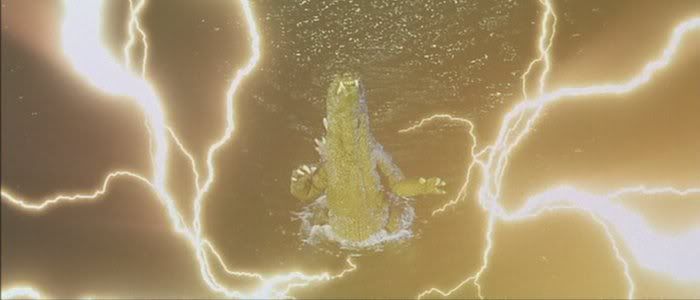
The climax may have been scaled down, but it is real electrifying.
Still, GMK deserves its status as one of the “best of the best,” and it passed the test that night: the 375-seat theater was completely sold out. While there were a few people that got up and left before the credits rolled (no doubt to get home and into bed before two in the morning), the theater was still nearly packed at the end of the night, filled to the brim with enthusiastic fans and moviegoers chatting over the spectacle of giant monsters smashing shit that they had just seen. Some went home with their raffle prizes (not me, I didn’t enter), and some grabbed last-minute photo opportunities next to the Godzilla mural or, better yet, with Godzilla himself (this, I did do!)

Whether or not we see another Godzilla movie from Kaneko (I sure hope we do!), we’ll definitely see another kaiju film at the Plaza, which obviously has staff members that love and appreciate the movies and their creators.
